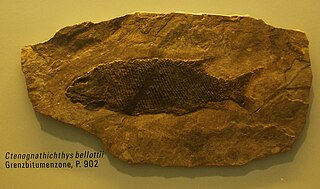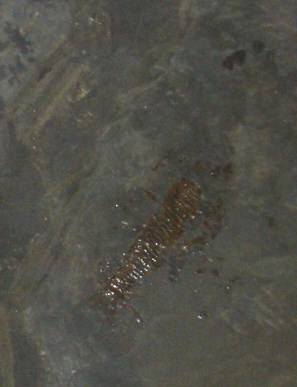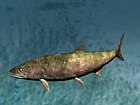
The Amiiformes order of fish has only two extant species, the bowfins: Amia calva and Amia ocellicauda, the latter recognized as a separate species in 2022. These Amiiformes are found in the freshwater systems of North America, in the United States and parts of southern Canada. They live in freshwater streams, rivers, and swamps. The order first appeared in the Triassic, and the extinct members include both marine and freshwater species, many of which are morphologically disparate from bowfins, such as the caturids.

Brookvalia is an extinct genus of prehistoric freshwater ray-finned fish that lived during the Middle Triassic epoch.
Eosaurichthys is an extinct genus of saurichthyid ray-finned fish that lived during the late Permian epoch in what is now China.

Ainia is an extinct genus of prehistoric ray-finned fish that lived during the Kimmeridgian stage of the Late Jurassic epoch. It contains a single species, A. armata, known from the famous Solnhofen Limestone of Germany. It is a distant relative of the bowfin, although it is more closely related to genera such as Caturus and Osteorachis.
Aphelolepis is an extinct genus of prehistoric ginglymodian bony fish. It contains one species, A. delpi, that lived during the Ladinian age of the Middle Triassic epoch in what is now Franconia, Germany. It is generally considered a semionotiform.
Luganoia is an extinct genus of prehistoric bony fish that lived during the Anisian and Ladinian ages of the Middle Triassic epoch. Fossils were recovered from the Besano Formation of Monte San Giorgio and Besano area and from the Zhuganpo Member of Guizhou, South China. It was also reported from the Ladinian of Spain.

Besania is an extinct genus of prehistoric marine ray-finned fish that lived during the Anisian and Ladinian ages of the Middle Triassic epoch in what is now southern/southeastern Switzerland and northern Italy. Fossils were recovered from the Besano Formation of Monte San Giorgio area and the Prosanto Formation of canton Graubünden, Switzerland.

Ctenognathichthys is an extinct genus of prehistoric marine ray-finned fish that lived during the Middle Triassic epoch of Europe, in the former Tethys Ocean.

Habroichthys is an extinct genus of prehistoric bony fish that lived during the early Ladinian stage of the Middle Triassic epoch, 242 to 232 million years ago. It has been found in Austria, China, Italy, Slovenia, and Switzerland. It was a small fish measuring 26 cm (10 in) long.
Cephaloxenus is an extinct genus of prehistoric marine ray-finned fish that lived during the early Ladinian stage of the Middle Triassic epoch.
Alleiolepis is an extinct genus of prehistoric bony fish, which lived during the Ladinian age of the Middle Triassic epoch in what is now Franconia, Germany. It is generally considered a semionotiform. It was first named Leiolepis, but because this genus name is preoccupied by an extant lizard, the genus name of the Triassic fish was changed to Aleiolepis.

Allolepidotus is an extinct genus of prehistoric marine neopterygian ray-finned fish from the Middle Triassic epoch of what is now Italy, Spain, and Switzerland. It was formerly referred to the halecomorph order Panxianichthyiformes, but is now thought to be a member of the Ionoscopiformes.

Bobasatrania is an extinct genus of prehistoric marine ray-finned fish that survived the Permian-Triassic extinction event. Fossils of Bobasatrania were found in beds of Changhsingian to Ladinian age. It was most speciose during the Early Triassic.

Cyranorhis is an extinct genus of prehistoric marine ray-finned fish that lived during the Serpukhovian age of the Carboniferous period. One species is known, C. bergeraci in the Bear Gulch Limestone what is now Montana, United States. It is named after French novelist Cyrano de Bergerac.

Colobodus is an extinct genus of marine Triassic ray-finned fish of the family Colobodontidae and order Perleidiformes. Fossils have been found in Europe and China, encompassing the former Tethys Ocean. It could reach body lengths of about 70 cm.

Halecomorphi is a taxon of ray-finned bony fish in the clade Neopterygii. The only extant Halecomorph species are the bowfin and eyespot bowfin, but the group contains many extinct species in several families in the order Amiiformes, as well as the extinct orders Ionoscopiformes, Panxianichthyiformes, and Parasemionotiformes. The fossil record of halecomorphs goes back at least to the Early Triassic epoch.
The Zhuganpo Formation is a Triassic geologic unit found in southern China. It has historically been known as the Zhuganpo Member of the Falang Formation. A diverse fossil assemblage known as the Xingyi biota or Xingyi Fauna can be found in the upper part of the Zhuganpo Formation. Fossils of the Xingyi biota include articulated skeletons of marine reptiles, abundant fish, and a plentiful assortment of invertebrates indicating a Ladinian to Carnian age for the sediments of the formation.

Ginglymodi is a clade of ray-finned fish containing modern-day gars (Lepisosteidae) and their extinct relatives in the order Lepisosteiformes, the extinct orders Semionotiformes and Kyphosichthyiformes, and various other extinct taxa. Ginglymodi is one of the two major subgroups of the infraclass Holostei, the other one being Halecomorphi, which contains the bowfin and eyespot bowfin and their fossil relatives.

Parasemionotiformes is an extinct order of neopterygian ray-finned fish that existed globally during the Triassic period. It comprises the families Parasemionotidae and Promecosominidae. Many of the included genera are monotypic and most species lived during the Early Triassic epoch.

Redfieldiiformes is an extinct order of ray-finned fish (actinopterygians) which lived from the Early Triassic to Early Jurassic. Redfieldiiforms were fairly typical Triassic fish in overall anatomy. They had a fusiform body shape with thick, ganoine-covered scales. The dorsal and anal fins were large, positioned opposite from each other, and shifted back, close to the tail. The caudal fin was hemiheterocercal, with the vertebral column and body scales extending into an upper lobe equal in size and shape to the lower lobe. They also had several characteristic skeletal traits, such as a hatchet-shaped preopercle, a series of fulcra fringing the fins, a reduced number of branchiostegal rays, and a snout ornamented with tubercles.
















